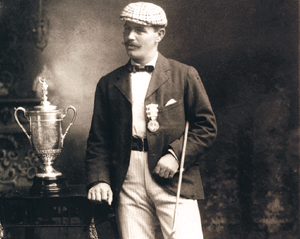James Foulis
| James Foulis | |
|---|---|
| — Golfer — | |

Foulis in 1895 with the U.S. Open trophy,
and wearing the winner's medal. |
|
| Personal information | |
| Born |
22 August 1871 St Andrews, Scotland |
| Died | 3 March 1928 (aged 56) Chicago, Illinois, U.S. |
| Nationality |
|
| Career | |
| Status | Professional |
| Professional wins | 1 |
| Best results in major championships (wins: 1) |
|
| U.S. Open | Won: 1896 |
| The Open Championship | DNP |
| PGA Championship | DNP |
James Foulis (22 August 1871 – 3 March 1928) was a Scottish-American professional golfer who won the second U.S. Open in 1896. He also finished tied for third in the inaugural 1895 U.S. Open held at Newport Golf Club in Newport, Rhode Island.
Foulis was born at the "Home of Golf", St Andrews in Scotland, on 22 August 1871. His father was foreman at Old Tom Morris's golf shop and clubmaking business, and Foulis spent some time working at the shop. In 1895 he travelled to the United States to take up a job as golf professional at Chicago Golf Club, which was the first club in the United States to have an 18-hole course. He was the first golf professional in the western States.
Foulis was one of the eleven players who took part in the first U.S. Open in 1895, and he came third.The following year he won the tournament at Shinnecock Hills Golf Club on Long Island. He was representing the Chicago Golf Club and he won $200. He was helped out by the fact that twice British Open champion Willie Park, Jr., who would have been odds-on favourite if he had reached the United States in time to play, did not arrive in America until the day after the tournament. The following year the Open was played at Foulis's home club, and he finished tied for third with Willie Dunn, Jr. The most notable aspect of his game was his driving; it is said that he often drove over three hundred yards using the relatively primitive clubs of his day. He continued to compete in the U.S. Open until 1911, but did not win again.
Jim Foulis and his brother David ran a golf shop at the Chicago Golf Club, and played a significant part in the evolution of golf equipment. They invented the bramble patterning for Coburn Haskell's new rubber-cored ball. In response to the demands of the new ball they developed the "mashie-niblick", the modern 7-iron, which fell between the traditional mashie (5-iron) and niblick (9-iron), and patented the design. Jim Foulis also worked as a golf course designer from 1896 until his death, designing the first golf courses in many communities across the American midwest.
...
Wikipedia
